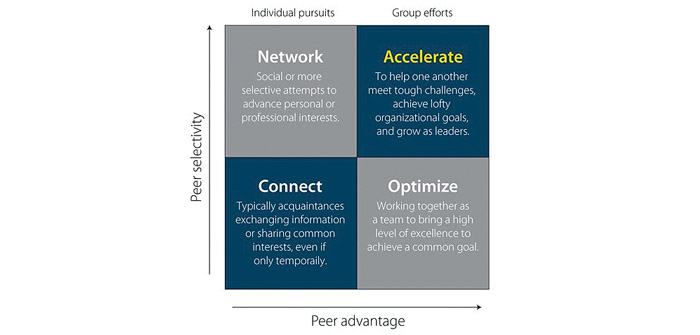(Graphic | courtesy of CrossPointe, Inc.)
If you are a leader, you’re well-aware of the need to continually grow and build your leadership skills. The marketplace is in constant change. Shifting employee demographics demand fresh leadership perspectives. A steady stream of new government regulations, a troubled economy, political uncertainty… the list goes on and on. And it requires all of us as leaders to unrelentingly sharpen our abilities.
But how do you do it? You can read leadership books and articles. You can listen to podcasts. You can attend workshops and seminars. You can watch TED Talks and You Tube videos. All those resources have their place and can be valuable. However, after 50 years in leadership roles, what I have found to be indispensable for leadership growth is to be in regular conversation with other excellent business leaders, sharing ideas, exchanging best practices and innovating together. However, not all leadership conversations are created equal.
In their book The Power of Peers, Leon Shapiro and Leo Bottary make distinctions essential to leadership growth, from which the diagram associated with this article is drawn. Leaders typically interact with one another in four ways:
- Connecting. Leaders stay loosely connected with one another these days primarily through social media, especially using LinkedIn. The key word here is “loosely.” Social media connections (when followed) produce awareness and some exchange of information and sharing of common interests, even if only temporarily. This connection is valuable to leaders, but does not truly build leadership proficiency or capacity.
- Networking. Networking, most commonly and most effectively done in person, provides a space for advancing personal or professional interests. However, unless networking contacts are actively converted into more advanced forms of leadership conversation, they prove to be simply an in-person form of connecting. There’s nothing wrong with networking. It can serve a purpose, but except for the relatively few of us who are “networking masters,” attending endless events simply to “network,” quickly grows tiring and unproductive.
- Optimizing. Leaders who come together to achieve a common goal are in pursuit of optimal outcomes, typically on a project basis. Leadership teams within an organization work together to achieve specific objectives. We also see this happening with productive non-profit boards, for example, perhaps for an annual fundraising campaign, or in the selection process for a new executive director. Another example is the way leaders who participate in service clubs like Rotary come together to produce a high impact event, like the annual Great Drake Park Duck Race. Although this might seem like just a simple fun opportunity to watch some plastic ducks frolic on the Deschutes River, the Duck Race is amazingly complex to execute, requiring the coordinated efforts of hundreds of highly skilled and motivated Rotarians. The outcome? A fun time… and millions of dollars raised for local nonprofits.
- Accelerating. While all the above ways for leaders to interact are valuable, they don’t directly address the need for each of us to accelerate our individual leadership capacity on a long-term, ongoing basis. The most effective way to produce accelerated leadership growth is for leaders to participate in confidential, noncompeting peer groups with other high-performing leaders. One example of this is participation in Vistage International, (Vistage.com) the largest private advisory program for CEOs in the world. Over 64-years old, Vistage has approximately 45,000 members worldwide. I’ve been associated with Vistage for over 30 years, as a member, speaker, consultant and as a mergers and acquisitions advisor to many Vistage member companies. As a mergers and acquisitions advisor, what I have consistently experienced is that when comparing a Vistage member company to a seemingly similar non-member company, the Vistage company always runs more efficiently, the company culture is healthier, the CEO’s life is more balanced (and more fun), the company is more profitable and more valuable. When the time comes to sell, the Vistage company is worth more… typically a lot more. The business is more marketable, more transferrable and operates more successfully post-closing, continuing the founder’s legacy. In short, through participation in Vistage, the business owner has accelerated their leadership capacity exponentially — and VERY profitably. In the Vistage group I facilitate locally, some of the region’s top business leaders meet monthly in private peer-advisory board sessions to innovate their businesses, strategize with each other to seize compelling opportunities, share best business practices, and tackle each other’s most pressing challenges in a confidential, noncompetitive, synergistic environment.
If you have high ambitions for your business and desire to operate with excellence, consider participating in a quality executive-level peer group, whether with Vistage or in some other format. If you do, you’ll discover the unparalleled power of an exceptional group of peers to help you grow your leadership capacity and accelerate your business. One way to get a small taste of peer-power is to join hundreds of top leaders at the upcoming Excellerate Central Oregon Business Forum, the region’s premier annual business conference on September 27, 2024 at the Riverhouse Convention Center. ExcellerateCentralOregon.com.
Michael Sipe is a mergers and acquisitions advisor and executive coach.





